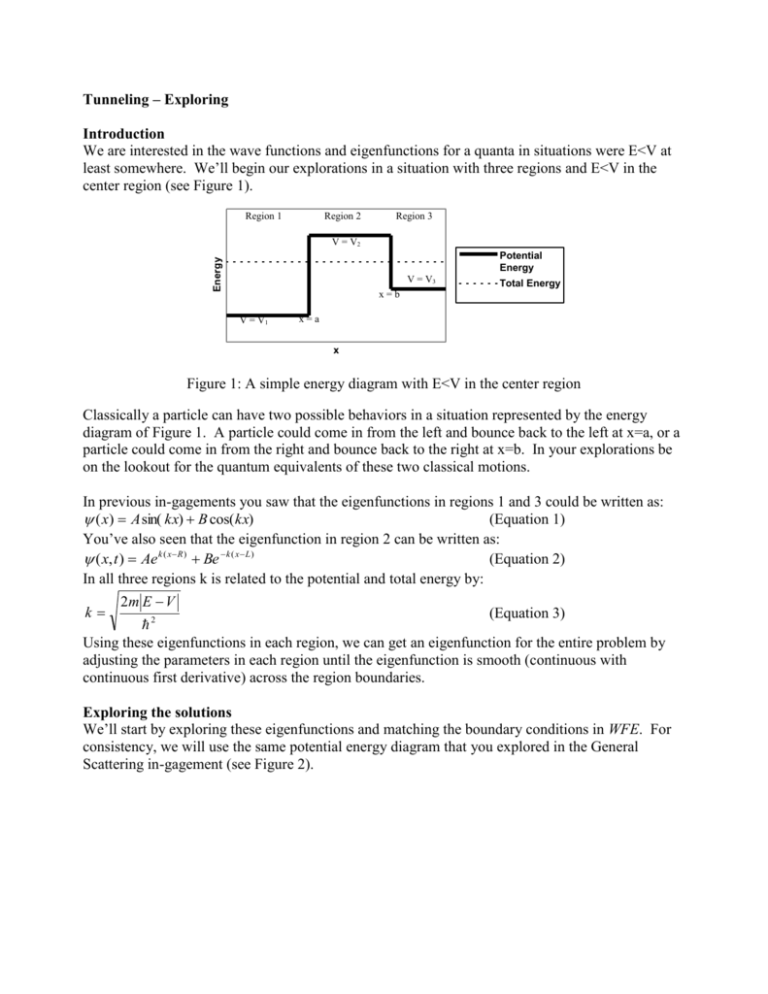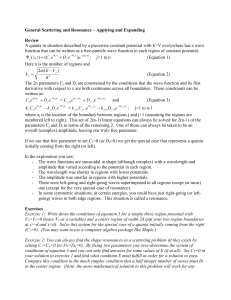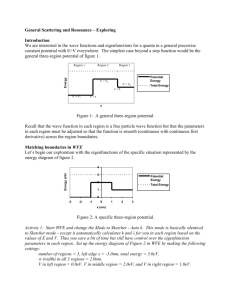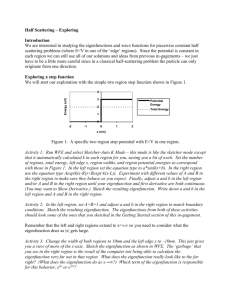Exploring
advertisement

Tunneling – Exploring Introduction We are interested in the wave functions and eigenfunctions for a quanta in situations were E<V at least somewhere. We’ll begin our explorations in a situation with three regions and E<V in the center region (see Figure 1). Region 1 Region 2 Region 3 V = V2 Energy Potential Energy V = V3 Total Energy x=b V = V1 x=a x Figure 1: A simple energy diagram with E<V in the center region Classically a particle can have two possible behaviors in a situation represented by the energy diagram of Figure 1. A particle could come in from the left and bounce back to the left at x=a, or a particle could come in from the right and bounce back to the right at x=b. In your explorations be on the lookout for the quantum equivalents of these two classical motions. In previous in-gagements you saw that the eigenfunctions in regions 1 and 3 could be written as: ( x) A sin( kx) B cos( kx) (Equation 1) You’ve also seen that the eigenfunction in region 2 can be written as: (Equation 2) ( x, t ) Ae k ( x R ) Be k ( x L ) In all three regions k is related to the potential and total energy by: 2m E V k (Equation 3) 2 Using these eigenfunctions in each region, we can get an eigenfunction for the entire problem by adjusting the parameters in each region until the eigenfunction is smooth (continuous with continuous first derivative) across the region boundaries. Exploring the solutions We’ll start by exploring these eigenfunctions and matching the boundary conditions in WFE. For consistency, we will use the same potential energy diagram that you explored in the General Scattering in-gagement (see Figure 2). Energy (eV) 4 3 Potential Energy 2 Total Energy 1 0 -3 -2 -1 0 1 2 3 x (nm) Figure 2: A specific 2 region potential with E<V in the center region. Activity 1: Start WFE and change the mode to Sketcher. Set the number of regions, left edge x, region widths, and region potential energies to correspond to the parameters of Figure 2. Set the total energy to 1.98eV – just below the potential energy in the center region. In the two outer regions, use set the equation type to a*sin(kx+b). (Recall that this is easier to use than Asin(kx)+Bcos(kx).) In the center region use the new equation type of Aexp(k(x-R))+Bexp(-k(x-L)). Set k in each region to the correct values calculated from Equation 3 (use the mass of an electron as always). Finally, adjust the A's and B's until your function and first derivative are both continuous at both boundaries. (You may want to Show Derivative). Sketch the resulting eigenfunction. Remember, in this case you still have two free parameters, so this is just one possible eigenfunction. Let's look at one more. Activity 2: Change A and B in the middle region to something new (like 1.2 and -0.7). Then adjust A and B of the outer regions to rematch the boundary conditions. Sketch the resulting eigenfunction. Now let's look at the wave functions and probability densities in motion. Activity 3: Change to Explorer mode and press the run button to watch the time behavior. Press stop and sketch the wave function and probability density. Press run and describe their time behavior. Since this case has two free parameters, you can again set the connect direction and left or right region parameters – just like in the general scattering case. These parameters will have the same effect as they did before. As long as you use sine-cosine type wave functions, you will get standing waves - which are superpositions of the two basic traveling wave solutions. Let's look at those two traveling wave solutions instead. Activity 4: Set the connect direction from left to right. Set C=0 and D=1. Sketch the shape and describe the time behavior of this wave function and probability density. What physical situation does it represent? Why do you say that? Activity 5: Repeat Activity 4 with a connect direction from right to left and C=1 and D=0. As you see, when the traveling wave comes in from the left (or right) it is almost completely reflected back to the right - almost creating a standing wave in the left (or right) region. However, unlike a classical particle, some of the wave does make it through region 2 and then continues on its way as a traveling wave on the right (or left) side of the barrier. This phenomenon is called tunneling and is another result that sets quantum mechanics apart from classical mechanics. Although all classical particles would bounce “bounce” back because of the forces at the edges of region 2, there is a small probability that some quanta will show up on the other side of this region having somehow made it through even though E<V. You can see just how high this probability is by calculating the transmittance (and reflectance) coefficients. (Which you will do as a homework problem.) This probability of tunneling basically depends on the width and magnitude of the potential in region 2. Activity 6: Before going on to the next activity, make some predictions. As the magnitude of the potential in region 2 increases do you expect the probability of tunneling to get bigger or smaller? Why? As the width of region 2 gets narrower do you expect the probability of tunneling to get bigger or smaller? Why? Activity 7: Use WFE to test your hypotheses of Activity 6. To do this simply change the potential energy and the width of the center region and see how it effects the amplitude of the probability density. Describe your experiments and results. Were your predictions correct? More regions and more resonances You can experiment in WFE with the traveling wave functions for lot of different potentials with lots of regions. For the most part, you will find that the behavior is very similar to what you have seen so far (as long as you keep E>V in the two edge regions – we’ll explore what happens when E<V in an edge region in the next two in-gagements). But there is one very important phenomenon that you have not yet seen. This phenomenon is a type of resonance - but it is somewhat different than the resonances you have seen before. Activity 8: Start WFE and put it into Explorer mode. Set the number of regions to 5. This will automatically set all of the region widths to 1.2nm. Set the total energy to 0.99eV and the potential energies in the 5 regions to: 0.0eV, 1.0eV, 0.0eV, 1.0eV, and 0.0eV (from left to right). Connect from left to right with a left eigenfunction of Cexp(ikx)+Dexp(-ikx) and C=0 and D=1. This represents a traveling wave coming in from the right. Click run to examine the behavior of the wave function and then sketch the probability density. Since this quanta is originally coming from the right and it runs into a region of potential where E<V most of the wave bounces back to the left - almost making a standing wave in the right region. But some does tunnel through to the center region - resulting in a small but nonzero probability density there. As the wave tries to continue to the left it again encounters a region where E<V and again very little of the wave makes it past that region into the far left region - resulting in a extremely small probability density there. Activity 9: Based on what you have observed in WFE previously, make a prediction about how you think the wave function will change as you lower the total energy. Explain your reasoning. Activity 10: Lower the total energy slowly towards about 0.75eV. Is the probability density behaving as you expected? When you get to about 0.75eV sketch the probability density. Lowering the total energy has the same effect as raising the potential energy levels in the two tunneling regions - so less of the wave function makes it through. As a matter of fact, so little makes it through that the graph of the probability density looks flat - right at zero. In reality, if you could zoom in on the graph you would still see very small fluctuations (they are easier to see in the wave function graph). Activity 11: Now, continue to lower the total energy slowly towards about 0.57eV. What happens to the probability density as you get near this energy? Sketch it. Activity 12: Keep lowering the total energy slowly towards about 0.558eV. Now what happens to the probability density? Sketch it. This phenomenon is a very important type of resonance. Unlike the resonances you have seen before where there was little or no reflection at certain energies in this resonance the probability density in the central region gets to be much greater than in the edge regions. So the quanta has a much greater probability of being found in the center region than in an equal sized piece of the edge regions. It is almost as if the quanta is trapped in the center region. In reality, it is not trapped at all - since the two edge regions continue on out to x=±∞ the total probability of the quanta being in those regions is still greater than the total probability of it being in the center region. (Remember that the total probability is the probability density integrated over a piece of the x-axis.) What can really happen is that a quanta with this energy can act as if it is trapped in the center region for a short period of time so that if you see it only during that time you will think it is in a bound state - but eventually it will end up leaving the center region to one side or the other. (You will learn more about how this actually works when you study wave packets which are actually superpositions of the stationary states that you are looking at here.) This resonance is related to some types of radioactivity. For example, in alpha decay the alpha particle is not actually originally bound to the nucleus - it is in a resonance state. It acts like it is bound to the nucleus for a while but eventually it ends up away from the nucleus as a separate alpha particle. Activity 13: There is another (lower) resonance energy for the situation that you have setup in WFE. Find it by slowly lowering your total energy towards 0.0eV. You will have to watch very closely - it is easy to go right by it. Remember that clicking near the center of the total energy control makes the energy change very slowly. When you find the exact resonance energy the probability density will look like it is exactly zero in the two edge regions but it isn't quite. Sketch the probability density when you find the resonance and write down the resonance energy. The situation represented by this potential diagram has only two resonances - it would have had more if the second and fourth regions had had higher potential energies. Activity 14: Raise the potential energies of the second and forth regions from 1.0eV to 1.5eV. Now there will be three resonances with total energies between 0.0eV and 1.5eV. Find them all, sketch them, and write down their resonance energies. How do they compare to the resonance energies you found in Activity 13? Activity 15: If you had raised the potentials even higher you would have gotten even more resonances - predict what their probability densities would look like. About how long does the wavelength in the center region have to be in order to get a resonance? Explain. Once you have predicted the wavelengths calculate the resonance energies. About how high will you have to raise the potentials in the second and forth regions in order to have 5 resonance energies? Sketch predictions of the probability densities of these 5 resonances? What will be their approximate energies? After you have made your predictions, test them in WFE! Unlike the resonances that you studied earlier, these resonances do not require symmetry to occur they only require a local minimum in the potential energy. This makes them even more like a bound state - since classically a local minimum in the potential energy will always have bound state solutions. In quantum mechanics a local minimum is insufficient to produce bound states - this is because of the exponential shape of the wave functions in the regions where E<V - there will always be at least some tunneling in these regions. The probability density function will always be nonzero in the edge regions and thus there will always be some probability of finding the quanta “outside” of the region of the local minimum. In other words, it won’t really be bound. Of course, if the regions around the local minimum are very wide and/or have very large potentials then the wave function will shrink more rapidly - leaving only a very tiny probability density outside the minimum. Such a quanta can seem to remain bound for a very long time (the state will have a very long half life) but will eventually end up on the outside. Like the resonances that you studied earlier (and like all resonances), these resonances only occur at certain special energies - the resonance energies. Mathematically the resonances occur because the problem becomes over-determined, there are too many conditions and not enough free parameters to satisfy them. So the problem only has solutions at certain values of total energy – if at all. You will see a similar thing when you study bound states and it is this very property (only certain energies have solutions) that gives quantum mechanics its name.







